Akko (Acre) – Visitor Guide with Photos
Acre (Akko) is a port city in northern Israel. It is one of the world`s oldest cities, with a rich history and many historic structures.
Table of Contents
- 1 Basic Info
- 2 Acre Names
- 3 What Does Akko Mean?
- 4 Acre and Napoleon
- 5 UNESCO World Heritage List
- 6 Tours
- 7 Old Acre Development Company
- 8 Opening Hours
- 9 Entrance Fee
- 10 Coupons
- 11 Map
- 12 Directions
- 13 Attractions in the Old City of Akko
- 13.1 The White Market
- 13.2 Hospitaller Fortress (Knights Halls)
- 13.3 Al-Jazzar Mosque
- 13.4 Okashi Art Museum
- 13.5 Hamam al-Basha – Turkish Bath
- 13.6 Templars Tunnel
- 13.7 Lighthouse
- 13.8 Saint John’s Church
- 13.9 Khan al-Umdan – Khan of the Pillars
- 13.10 Acre Port
- 13.11 Akko Market
- 13.12 Treasures In The Walls Museum
- 14 Attractions in Modern Akko
- 15 Attractions Near Akko (Acre)
- 16 Walking Routes
- 17 Where To Stay
- 18 Common Questions
- 19 Summary
Basic Info
Acre is a historic city in Northern Israel. It is located on the edge of Haifa Bay (on the coast of the Mediterranean Sea). Both land routes and sea paths (Acre has a natural harbor) made Acre a commercial standpoint. And it is one of the oldest cities in the world, continuously inhabited since the Middle Bronze Age (around 4,000 years ago).
Acre Names
Acre and Akko, Ace, Ptolemais, Antioch, Germanicia in Ptolemais, Colonia Ptolemais – all these names refer to the same city. But today, Akko and Acre are the ones that are commonly used.
Locals use the name Akko. Moreover, most road signs (except touristic ones) will say Akko. I guess this name is used since it was used in the Bible. Judges 1:31:
Nor did Asher drive out those living in Akko or Sidon or Ahlab or Akzib or Helbah or Aphek or Rehob.
After the Crusaders` conquest in 1104, the city was renamed Saint John of Acre (or shortly Acre), after the Knights Hospitaller, who had their headquarters there.
During this post, I will refer to the city as Acre and Akko.
What Does Akko Mean?
The short answer is that we do not know. And here is the elaborated answer:
The source of its name is unknown, however presumably, it is not Semitic. The Egyptians were using it as long ago as the second millennium BCE. But since hieroglyphics only have two consonants, the name was written as CK. There is no way of knowing how it was pronounced (the last syllable in particular).
In the letters of El-Amrana, which were written in Acadian, the letter H is used to signify the guttural Hebrew letters alef-hey-chet-ayin; accordingly, the name of the city could be written either as Haca or Aca. Had the name not been preserved, we would not have been able to associate it with the name appearing in the hieroglyphics clearly.
The AKK spelling was preserved in the Assyrian language.
Ancient Hebrew legend has it that the Mediterranean Sea flooded the world, and when it reached the shore of Akko, it stopped short. As written in the Book of Job (38:11), “Hitherto shalt thou come, but no further.” In the legend, the Hebrew words “Ad Po” [hitherto] become “Ad ko” – hence, Akko [Akko].
Note: unless stated otherwise, all quotes were taken from the official site.
Acre and Napoleon
You will see references to Napoleon Bonaparte in many places around the city. And for example, in the movie at Turkish Bath – Hamam al-Basha, one of the characters mentions how they defeated Napoleon. And indeed, Acre is one of the few cities that withstood Napoleon’s siege.
After the siege and capture of Jaffa in 1799, Napoleon attacked Acre.
The Siege of Acre of 1799 was an unsuccessful French siege of the Ottoman-defended, walled city of Acre and was the turning point of Napoleon’s invasion of Egypt and Syria. It was Napoleon’s first strategic defeat as three years previously he had been tactically defeated at the Second Battle of Bassano.
Source: Wikipedia
UNESCO World Heritage List
The Old City of Acre was added to the UNESCO World Heritage List under the following criteria:
- Acre is an exceptional historic town that preserves the substantial remains of its medieval Crusader buildings beneath the Muslim fortified town dating from the 18th and 19th centuries.
- The remains of the Crusader town of Acre, above and below the present-day street level, provide an exceptional picture of the layout and structures of the capital of the medieval Crusader Kingdom of Jerusalem.
- Present-day Acre is an important example of an Ottoman-walled town. It has typical urban components such as the citadel, mosques, khans, and baths well preserved, partly built on top of the underlying Crusader structures.
Source: UNESCO
Tours
Before starting the visit, I just wanted to mention that Acre is a tourist destination. And many firms offer tours either only to the town or combined with other nearby attractions, like Haifa and Rosh HaNikra Grottoes. Therefore, if you love joining tours, see the Bein Harim offer above.
Old Acre Development Company
Most touristic sites in the city belong to Old Acre Development Company (official site). That allows them to sell combined tickets to various attractions in the city and outside.
The sites under their management are Hospitaller Fortress, Okashi Art Museum, Turkish Bath, Templar Tunnel, Visitors Center (near the Hospitaller Fortress), Treasures In The Walls Museum, and Ramchal Synagogue.
Opening Hours
Sites managed by Old Acre Development Company are open seven days a week.
Sunday – Thursday and Saturday: 9:00 – 18:00 (till 17:00 in winter).
Friday and holiday eve: 9:00 – 16:00
Notes:
- Winter time is November – March.
- Ramchal Synagogue is closed on Saturdays and holidays.
Entrance Fee
The basic combined ticket includes Hospitaller Fortress, Turkish Bath, The Okashi Museum, Templar Tunnel, the Treasures in the Walls Museum, and Ramchal Synagogue. It costs 49 NIS per person. On top of the basic combination, you can add additional sites like Rosh Hanikra, Haypark zoo, and others. So there is a variety of combo tickets.
Note: opening hours and ticket prices were updated in January 2023. In any case, recheck the official site before visiting.
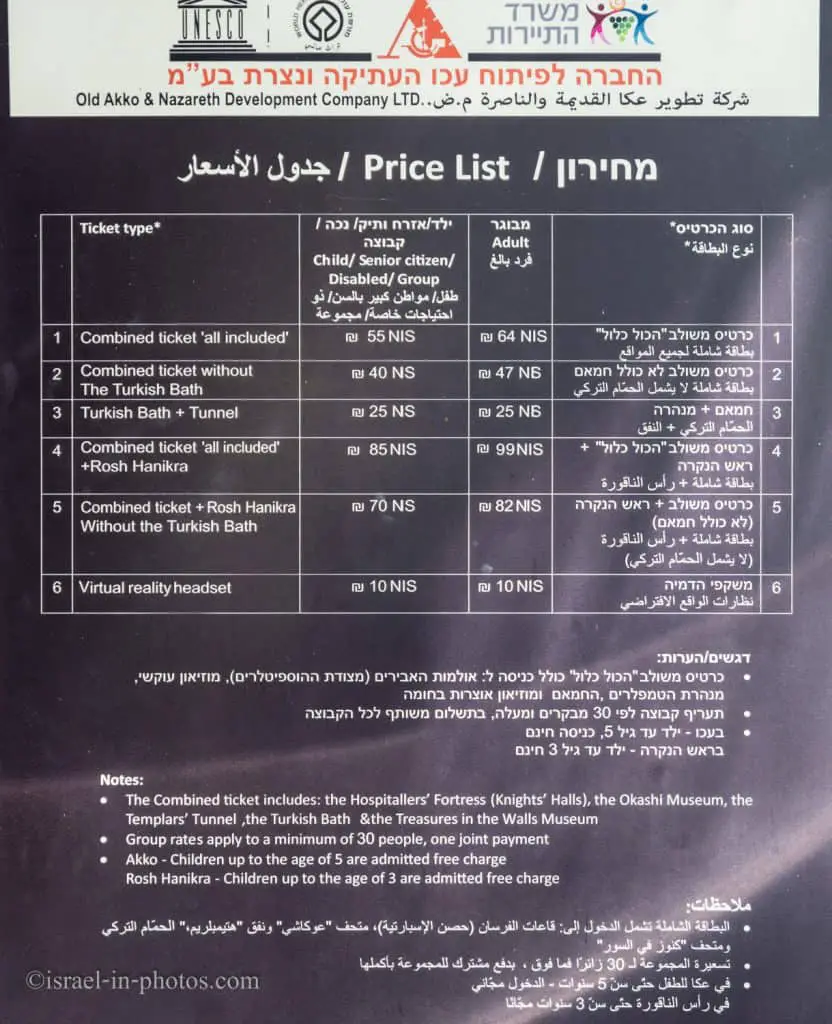
Coupons
I revisited Akko in August 2019 and used this coupon for that visit. It allows purchasing the basic combined ticket with and without the Turkish Bath at a 15% and 18% discount, respectively. I bought it through their site and received an SMS and an email with an order number. Then I told this number to the cashier at Hospitaller Fortress and received the tickets. Moreover, since coupon processing is fast, you can probably purchase through it on-site (but keep in mind there is a delay risk).
Map
Old Acre is the old part of the modern city of Acre. Furthermore, most of the tourist attractions are located within Old Acre. And most of this post will be dedicated to this small part of the city, where most attractions can be reached within a 5-minute walk.
Directions for drivers: Link to Waze and Link to Google Maps
Directions for public transport: Link to Moovit
Interactive map of the area:
Notes:
- The first map shows the city (the Old City is in the bottom left corner). And the second map shows a closeup of the Old City of Acre.
- As you can see from the first map’s scale, the size of the Old City is about 700 by 600 meters.
- You can click on the maps to enlarge them.
- You can also find a helpful map here.
Directions
Most attractions are located within the Old City. Thus the directions mentioned below are suited for those reaching the Old City of Akko.
Public Transport
Reaching Akko can be done in several ways. You can take the train to Akko station and walk from there. You can sail from Haifa (see Sails section below) or take a bus. Here is a link to Moovit with directions from Tel Aviv to Acre. You can change the starting point and get updated directions.
Parking
You can also reach the city by car. I always park outside the old town, in the new part of Acre. And I do not recommend entering the old city by car. The closer you get to the main attractions, the fewer parking spots (this is also true for paid parking). And I do not mind a five-minute walk. But if you want a closer parking lot, you can continue driving to the Land Gate, and just before the gate to the right, there is a paid parking lot.
I usually park not far from the Tunisian Synagogue (Eliezer Kaplan street 20, Acre) and walk toward the Land Gate. Before entering the gate, you will see the sea to your left. And if you continue in that direction for twenty meters, you will see Acre Port and its walls.
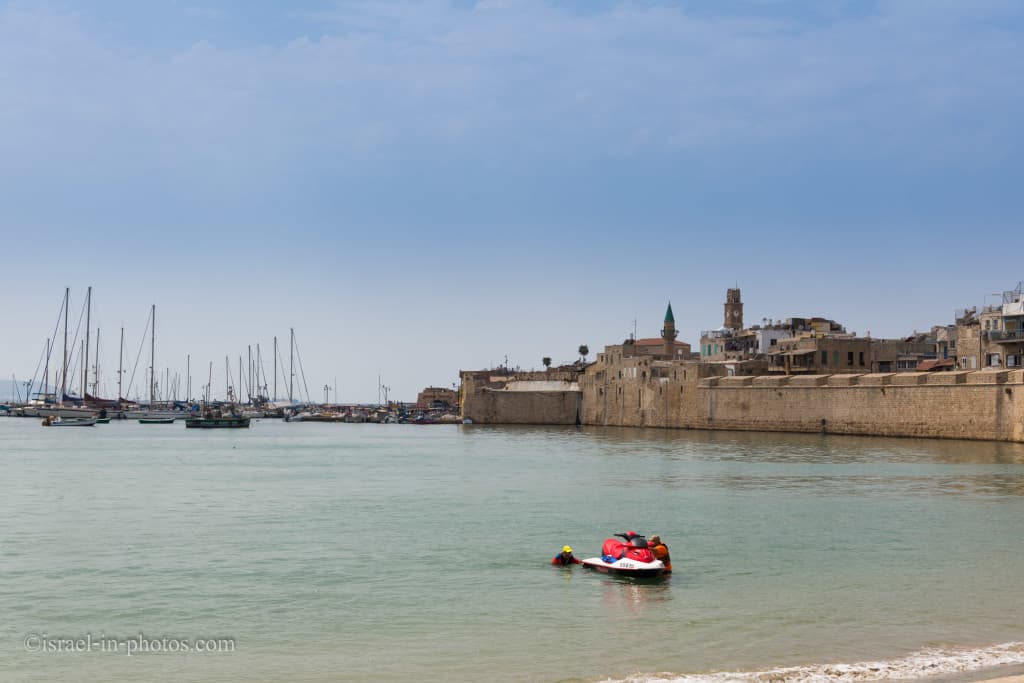
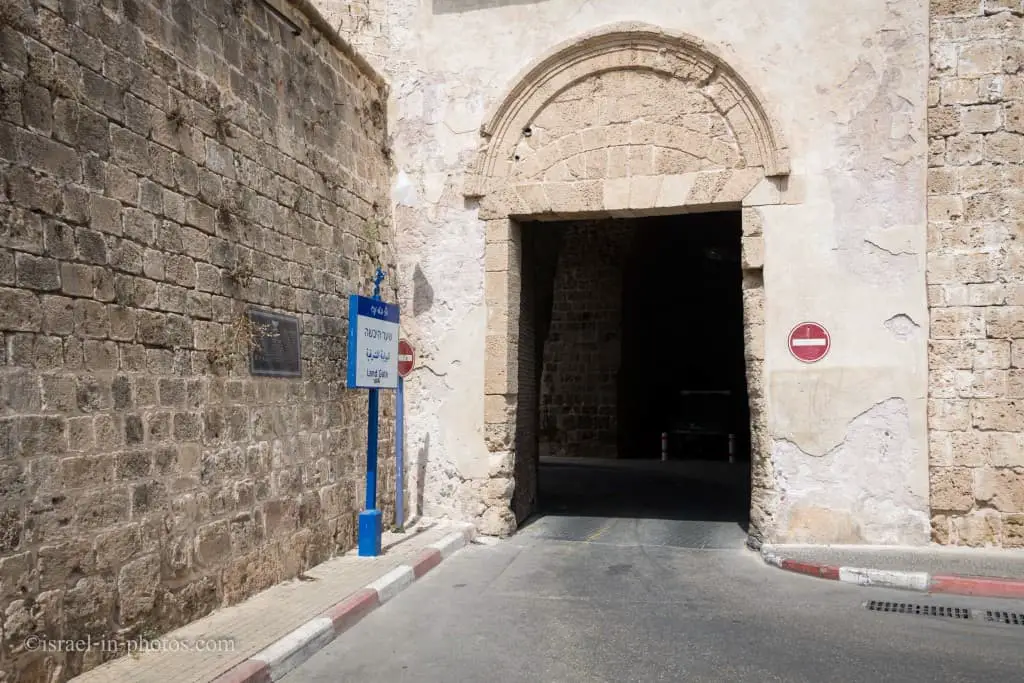
Attractions in the Old City of Akko
We will start by going through the attractions in the old city. And then check what is located further away.
The White Market
About 200m meters after you pass through the Land Gate, you can see The White Market on the right side:

The market’s walls and its sixty-four shops were whitewashed at the time they were built, hence the market’s name. The White Market is also filled with light, and perhaps that is why the attribute is often used by Acre’s inhabitants to this very day.
Unfortunately, today, the White Market is not that attractive. There are some restaurants, shops, and storage rooms. So, it lost its original charm, and the only thing worth looking at is the roof, which I showed above.
From the white market, we will head to our first stop, the Hospitaller Fortress.
Hospitaller Fortress (Knights Halls)
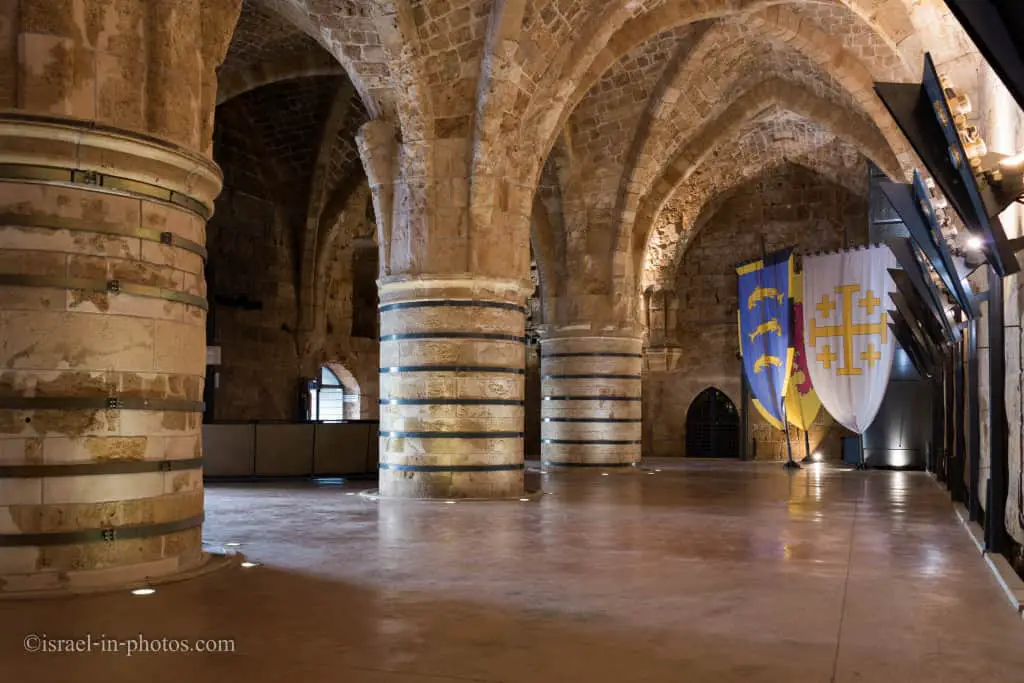
If you are reaching Akko, you probably want to visit this site. Moreover, Hospitaller Fortress (Knights Halls) is one of the reasons Acre made it to the UNESCO World Heritage List. Therefore, I would consider it a must-stop.
Note: Hospitaller Fortress (Knights Halls) is marked as #21 and #48 on the old city map.
Al-Jazzar Mosque
After a short walk from the Hospitaller Fortress, you can reach the Al-Jazzar Mosque, also known as the White Mosque.
It is the largest mosque in Israel outside of Jerusalem. And it also contains an interesting relic. You can find additional information at Al-Jazzar Mosque.
And since we were at Al-Jazzar Mosque, I want to mention two nearby places: Okashi Art Museum and Hamam al-Basha.
Note: Al-Jazzar Mosque is marked as #31 on the Akko old city map.
Okashi Art Museum
The entrance to Okashi Art Museum is located about 20 meters from the entrance to the Al-Jazzar Mosque. Okashi Art Museum is a small gallery, and due to its size, it can show the works of only several artists. I visited it twice, and on both occasions, it showed modern-style paintings.
If the entrance to Okashi Art Museum were not included in the combined ticket, I probably would not visit it, but since the display is changing, it is hard to know what to expect in advance.
Hamam al-Basha – Turkish Bath
Also, not far from the Al-Jazzar Mosque, you can find the Turkish Bath.

Note: Hamam al-Basha is marked as #20 on the Acre old city map.
“Hamam al-Basha” was built at the end of the 18th century by Governor of Acre, Jazzar Pasha. At first, it was called “Hama al-Jadid” (the new Hamam), but its name was subsequently changed to Hamam al-Basha (the Pasha’s Hamam), in honor of el-Jazzar. The Turkish bath’s construction was part of Acre’s transformation during the Ottoman Period from a small fishing village (primarily at the hands of al-Jazzar Pasha) into a teeming port city and a significant construction and trade center. During his reign, el-Jazzar strove to further the town in many and varied ways. Among his accomplishments is the aqueduct, which led the well water to the city. And the breakwater for safe docking at the port. Plus major buildings such as the Khan el-Umdan – Acre’s largest mosque – his luxurious palace and, of course, the Turkish bath.
The Turkish Bath compound consists of only several halls. There is the summer dressing room, four intermediary rooms, and a hot room. In those chambers, you will learn about the history of this place and the people that lived here, and you will also see a short movie. The whole visit will take about an hour.

And now, through the alleys of Old Acre, let’s head to The Templar Tunnel.
Here we are passing next to El-Zeituna Mosque:

Templars Tunnel
A 350-meter-long tunnel connected the Templars fortress and the Acre Port. And today you can walk there. See additional info at Templars Tunnel.
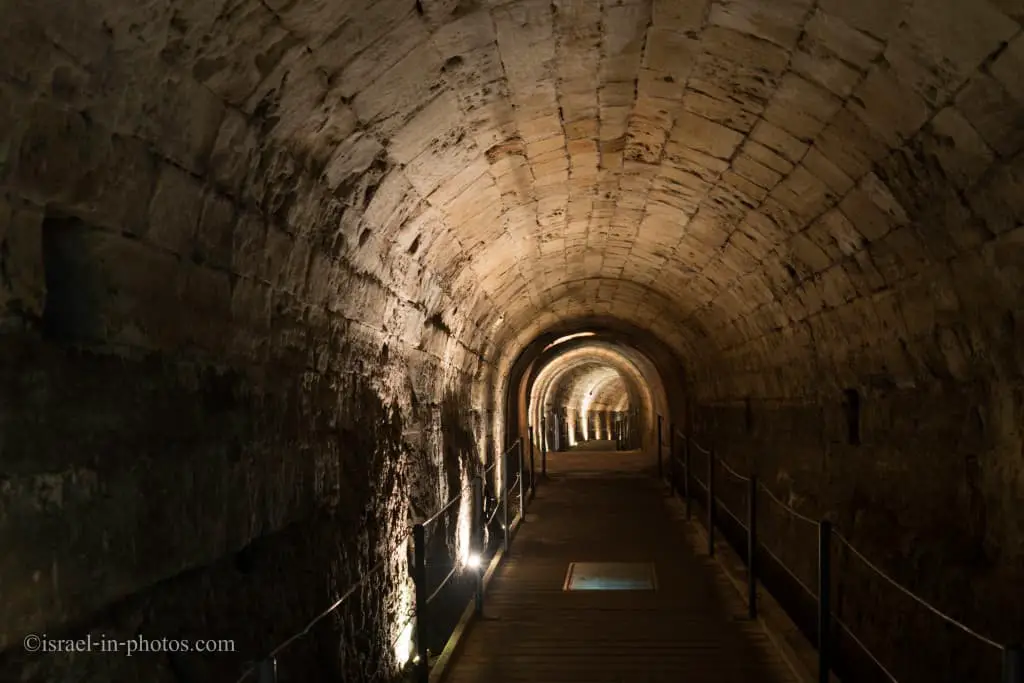
Lighthouse
One of the exits from the tunnel is next to the lighthouse. The lighthouse is where the Templars’ fortress used to stand. Here is the lighthouse during windy weather.
Note: the lighthouse is marked as #41 on the old city map.

Not far from the tower, there is usually this picturesque juice stand.
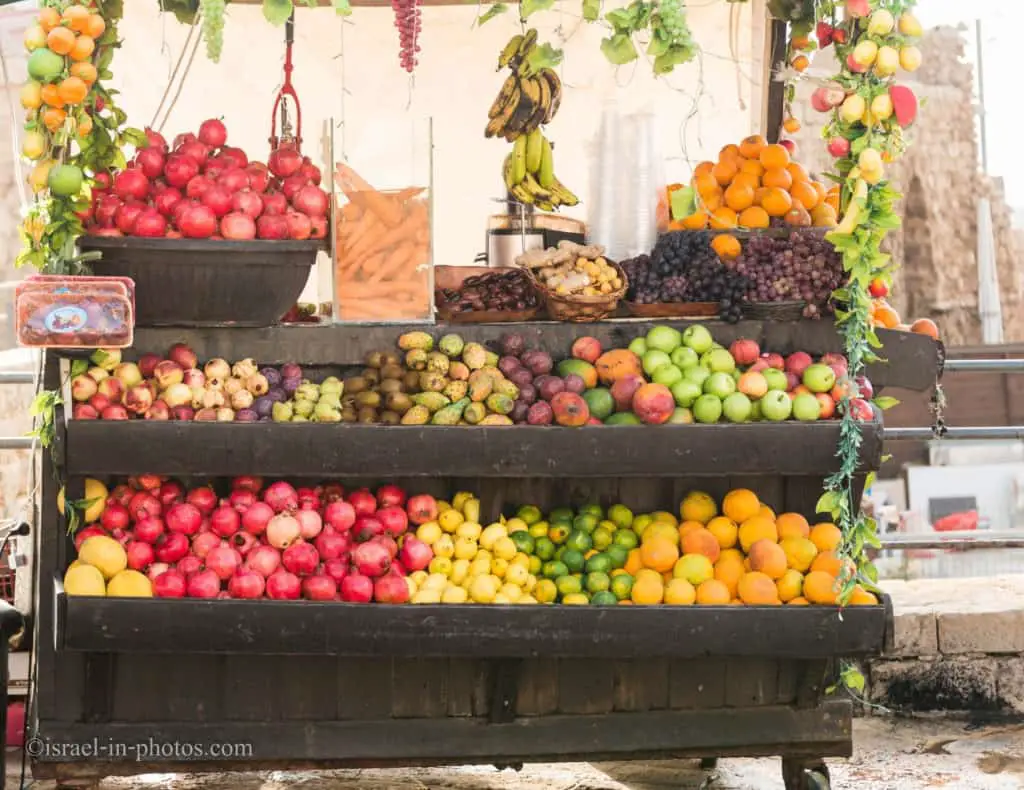
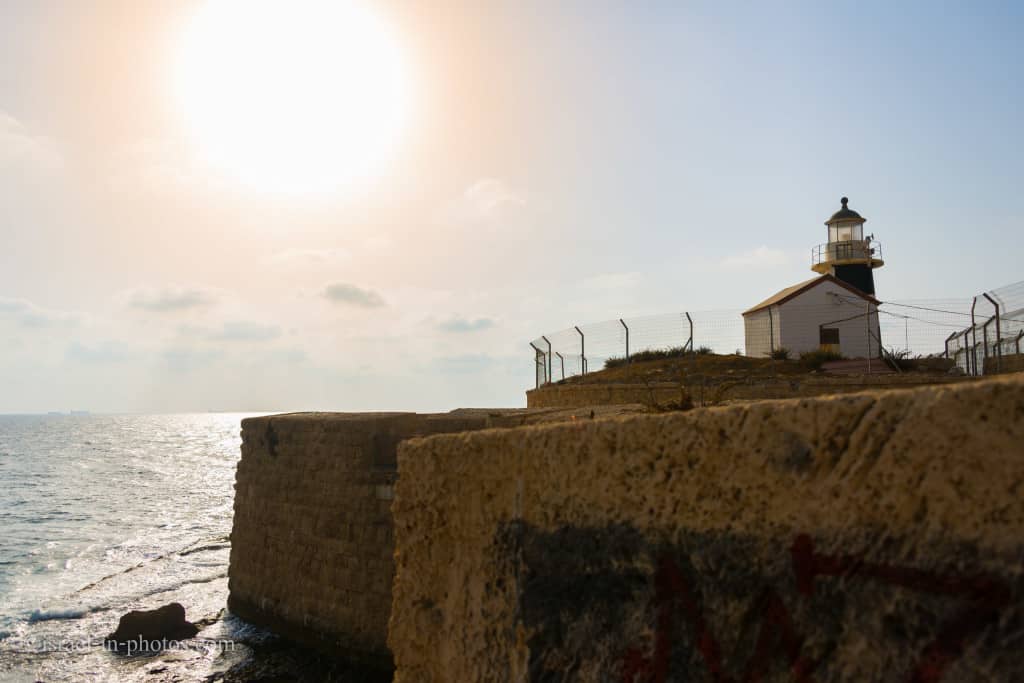
Saint John’s Church
A short walk along the old city Acre wall will lead us to Saint John Church.
Note: Saint John’s Church is marked as #26 on the Acre’s old city map.

Saint John’s Church, which currently stands next to Acre’s lighthouse, belongs to the Latin community (the Franciscans).
It is unclear as to when the church was built, although several years ago, the year 1737 was found engraved in the northern wall of the building. The church was renovated in 1947 and now serves as the only church of Acre’s Latin-Catholic community.
Source: official website
On the warmer days, teenagers jump from the Old Acre walls into the sea:
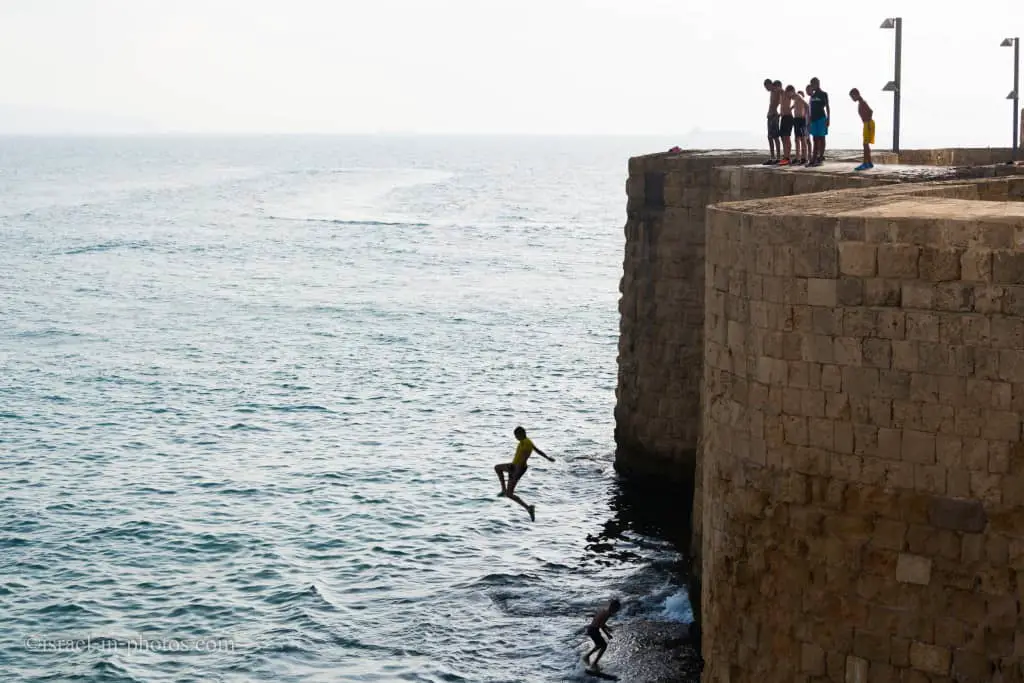
Their favorite spot is next to Saint John Church since there are stairs on the outer side of the barrier there:
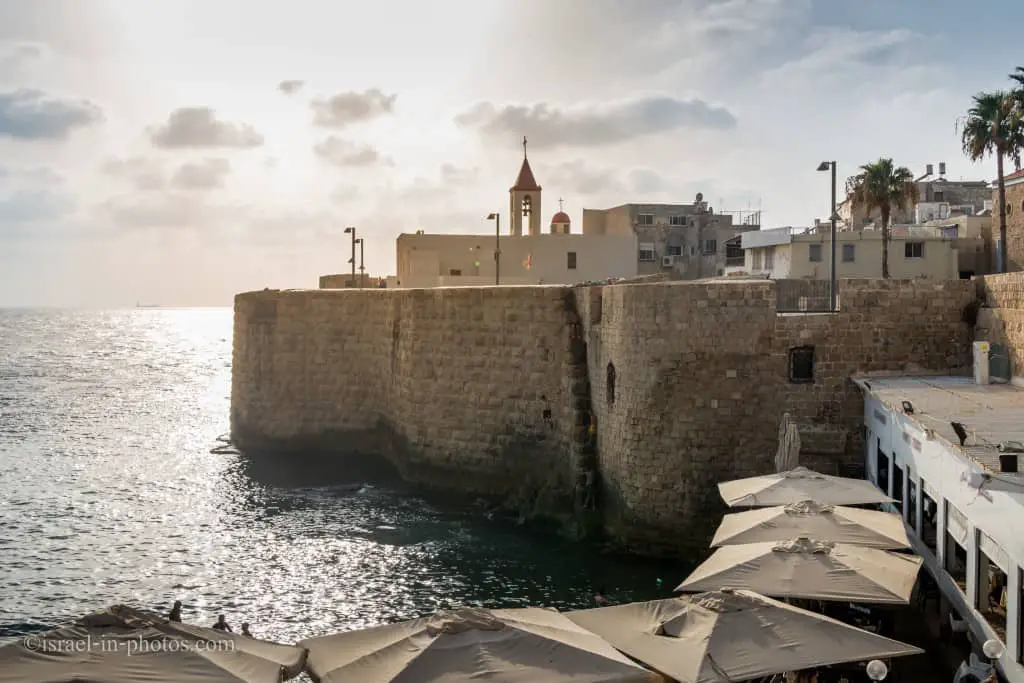
Khan al-Umdan – Khan of the Pillars
We almost returned to the point where we entered the Templar Tunnel. And near it, you can find Khan al-Umdan, also known as Khan of the Pillars.
Khan al-Umdan is the largest and best-preserved khan in Israel. And if you look at the clock tower, you can see that the clock was restored. But they did more than repair it. Now each side depicts numbers differently. Beyond the regular watch, you can also see Arabic numerals (in the following photograph) and Hebrew numbers.
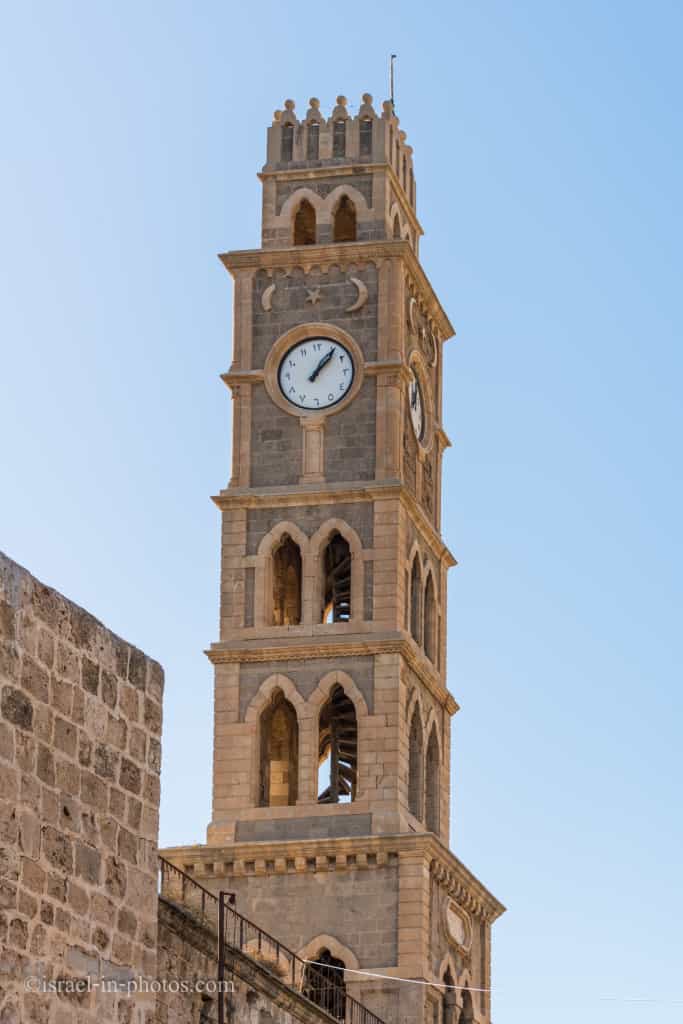
Khan al-Umdan is a large merchant’s inn adjacent to the port, which was used for international trade. Merchants who arrived at the port unloaded their goods in the inn’s storerooms on the first floor and slept in the second-floor rooms, which constituted a unique hotel.
The khan was built in the late 18th century by Ahmed al-Jazzar, and it rests on a row of granite pillars brought from various sites in the area.
The khan’s courtyard is open to visitors all day long.
We wanted to visit Khan of the Pillars, but unfortunately, it was closed. For years it was abandoned. And there were some lawsuits regarding converting it to a hotel. Maybe they closed it for restoration or to build a hotel inside it.
I took a photo of Khan al-Umdan’s interior back in 2014.

Note: Khan al-Umdan is marked as #10 on the Acre’s old city map.
Acre Port
And since we already mentioned the port, let’s head there.
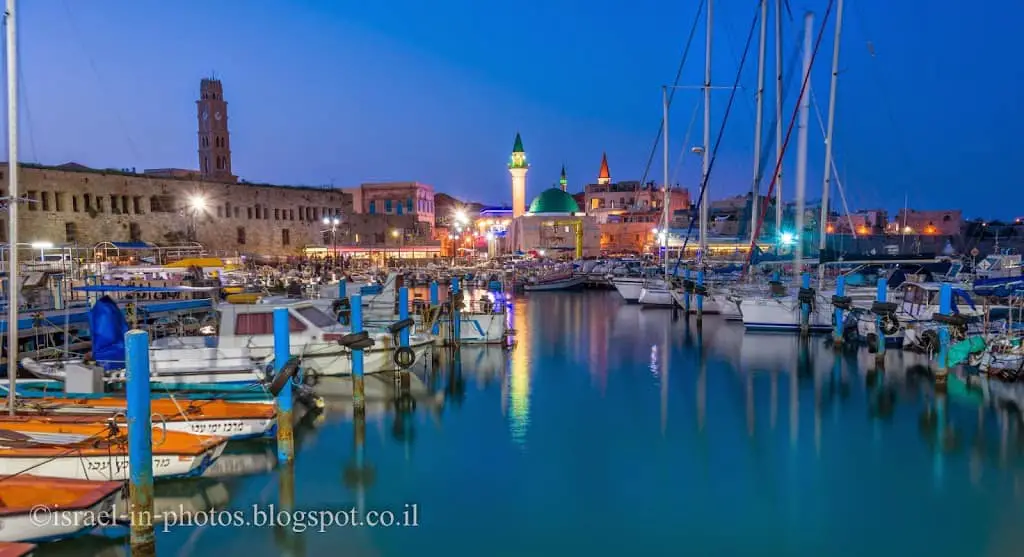
Note: Acre Port is marked as #45 on the old city map at the beginning of this guide.
At the guide to Acre Port, we will talk about history, sails, and Haifa – Akko ferry. So head on there for additional info.
Akko Market
The market is located in the old city, close to Acre Port and Al-Jazzar Mosque. You can walk towards Benjamin of Tudela street and see it.
It is not a big market, and you can pass it within 10 – 15 minutes. Though I love markets, and there is a variety of good markets in Israel, the Acre market lost its authenticity. The main reason is that many stands offer cheap Chinese goods. One of the only original things that remain in this market is food.
You can find fresh fish and traditional sweets. And if you are hungry, you can check out Hummus Said. It is a small hummus place that looks like a simple dining room and offers simple yet tasty dishes. It is located in the marketplace, and the opening hours are Sunday to Friday from 6:00 till they run out of hummus, typically 14:30.
And now, from the market, let’s head back toward the land gate (the gate we entered Old Acre through). We went there since it is near the Treasures In The Walls Museum.
Treasures In The Walls Museum
It is a lovely small Ethnographic museum. And you can read my guide to see additional info.
Note: Treasures In The Walls Museum is marked as #4 on the old city map.
Attractions in Modern Akko
So far, we have covered the Old City. And now, let’s look at additional sites outside of Old Acre. And let’s start with one of the most popular sites in the city.
Bahai Gardens in Akko
Bahaullah, the Prophet-Founder of the Bahai faith, resided at a mansion in Akko during his final years. His remains were laid to rest at a shrine, and today there is a big garden surrounding the area.
You can find my complete guide at Bahai Gardens in Acre.
Both Bahai Gardens in Haifa and Bahai Gardens in Acre (Akko) are stunning. But most people visit the ones in Haifa. You can check both of my guides and decide for yourself.
Note: the Bahai Gardens in Acre are marked as #1 on the Acre map.
Akko Beach
In the southern part of Akko, you can find a lovely short beach strip. You can easily spend half a day at these sandy beaches, which provide a nice view of old Acre. For additional information, check out Akko Beach (Argaman Beach).
Note: Akko Beach is marked as #37 on the Acre map.
Napoleon Hill – Tel Akko
On another occasion, we visited Napoleon Hill, also known as Tel Akko (marked as #11 on the Acre map). Tel Akko is located on a hill in the eastern part of the city near road #85. The Tel’s height is thirty meters, and it is pretty small, 600 meters on 350 meters at the widest part.
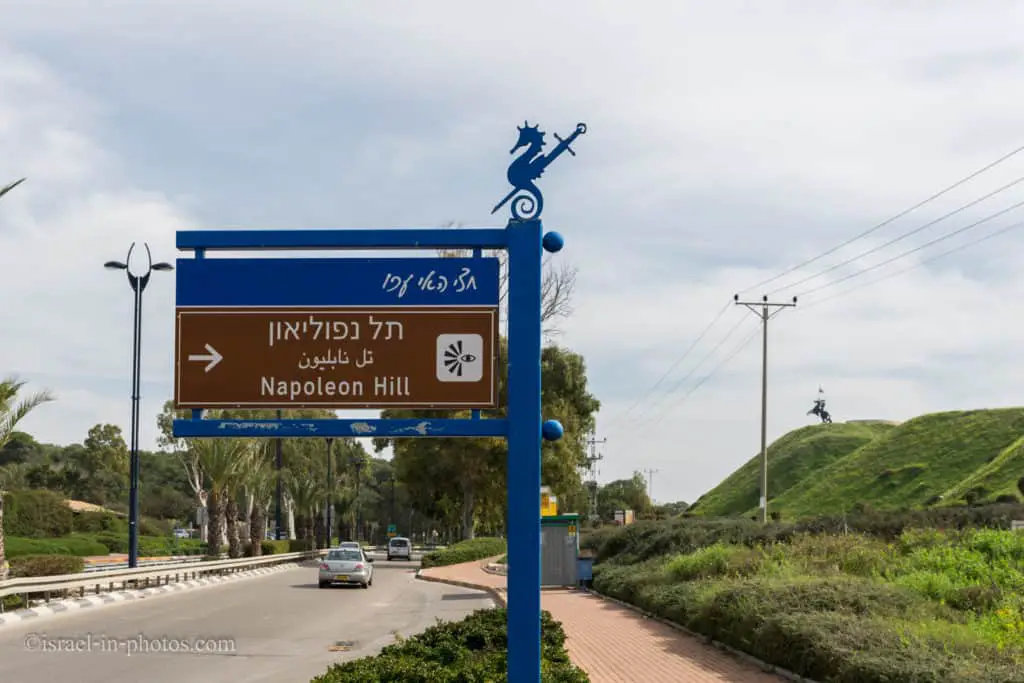
The hill has many flowers during the spring, making the walk enjoyable.
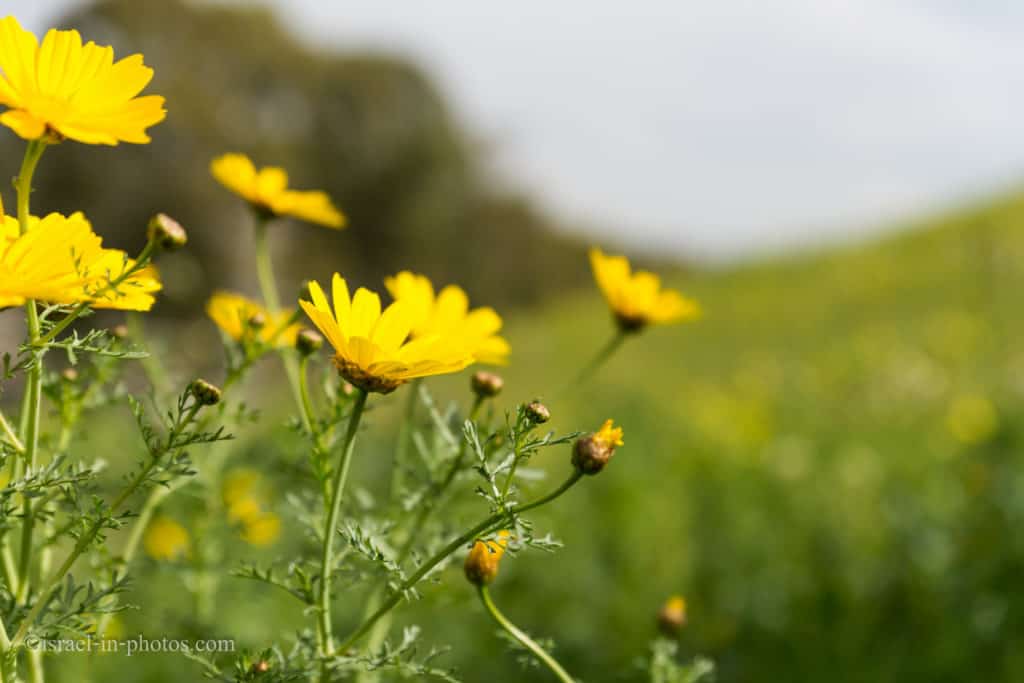
Here is a view from the hill towards the city center. On the left, you can see part of a soccer stadium with parking nearby (there are two trucks there). We parked our car there and used the stairs on the right to climb the hill.

In 2009, the touristic project of Tel Akko was introduced. In that project, paved roads for pedestrians and cyclists were created. And watchpoints, like the following one, were installed.
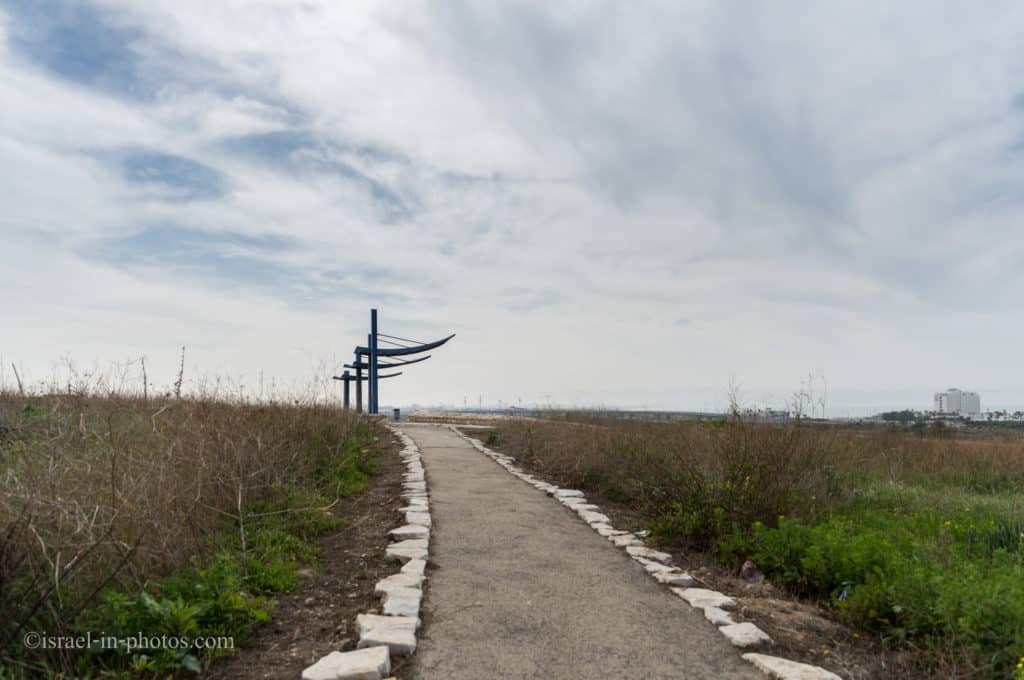
I was particularly interested in Tel Akko from a photography standpoint. Besides the regular walk, it was also a scouting mission. And this is what Old Acre looks like from Napoleon Hill.

I took that shot with a 70mm lens on a full-frame body. And as it turns out, the Tel is not a good viewpoint for photographers.
View to the East:

Napoleon at Acre
This Tel is also called Napoleon Hill, with a big statue installed at the top. It perpetuated Napoleon’s quest in 1799. During that quest, he tried to conquer Acre. And despite a long siege, the city has not fallen.
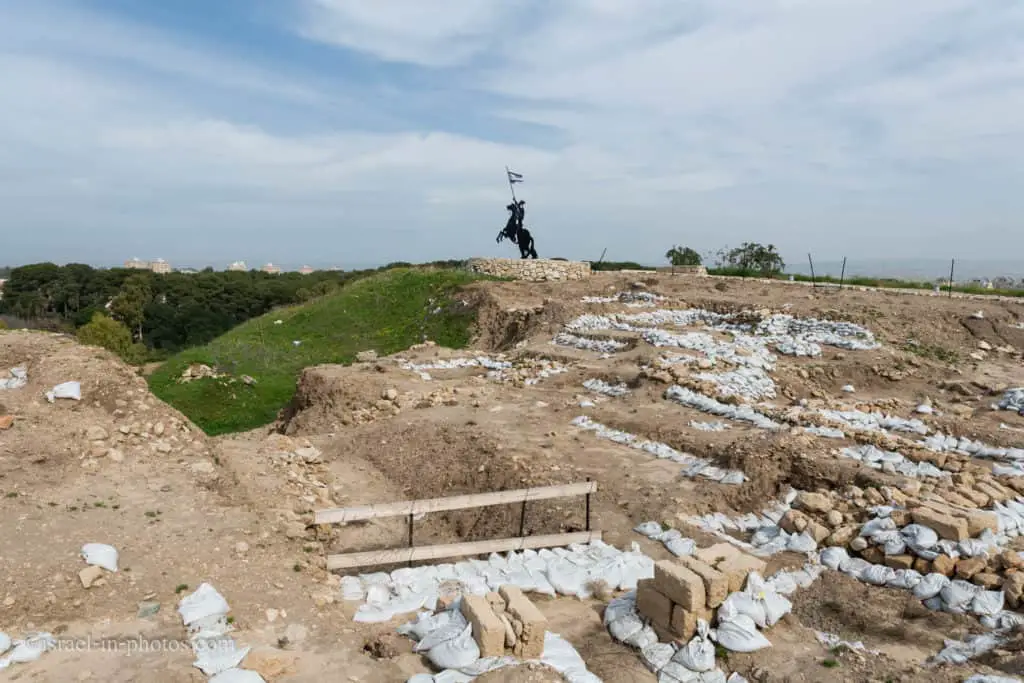
Near the statue, you can see an archeological site. That is a Tel. And you might think that the city of Acre was always in the same spot. But it started at this location. The town was at the same site until the Hellenistic period, when it moved closer to the sea to the west.
There are several routes around and near this Tel. We took the round path along the circumference of the top. The circular walk, with its several stops, took us about an hour.
Overall, the routes at the Tel are nice and short, but I would not consider them as top attractions in Acre.
Attractions Near Akko (Acre)
If you are thinking about making Acre your base, you can easily spend several nights there – one day exploring the city itself and another day exploring Haifa. Moreover, you can use the new sailing route I mentioned in Acre Port. Furthermore, you can spend one or several days exploring other attractions in this area. Here are several examples: Yehiam Fortress National Park and Rosh HaNikra grottoes. You can use the interactive map at the beginning of this post to find additional points of interest.
Walking Routes
In this guide, the attractions are divided by geographic location. Which is:
- Inside the Old City
- In the modern city of Akko and outside of the Old City
- Near the city
Note: all of the places are listed below.
The Old City is small (less than 1 square km), packed with attractions, and you can easily walk everywhere. Therefore many people visit only the Old City. Thus the following suggested walking routes refer only to sites in the Old City. On top of them (or instead of some of the mentioned sites), you can add additional attractions like Bahai Gardens in Akko.
What sites you should visit depends on various factors, like your interests and available time. I will answer this question using common interests, in other words, what most people do.
Suggested walking routes in the Old City according to available time:
- 2 – 3 hours: the Hospitaller Fortress. It will take most (if not all) of your time. And if you have some time, walk in the old city. Visit the alleys, Acre Port, and the market.
- 3 – 4 hours: in addition to the mentioned points of interest above, visit Al-Jazzar Mosque or The Templar Tunnel. You probably will not have enough time to visit both.
- 5 – 7 hours: this is probably the optimal duration. And it will allow you to visit the Hospitaller Fortress, Al-Jazzar Mosque, Templar Tunnel, walk in the old city, and even grab something to eat.
- Full day: to the places mentioned above, you can add the Turkish Bath and the lovely Treasures In The Walls Museum.
Where To Stay
The place of your stay depends on your route and where you decide to make your base. You can either stay at Acre (check prices and availability of both apartments and hotels on booking.com). Or you can stay in Haifa (Haifa district on booking.com) and reach the city by public transport. Another alternative would be staying somewhere in the area and reaching Akko by car for a visit (North district on booking.com).
Booking.comCommon Questions
Akko is an ancient port city in northern Israel. It is one of the oldest cities in the world, continuously inhabited since the Middle Bronze Age. And today, it is a popular travel destination.
Akko is mentioned in Egyptian writings from the 15th century BCE. But archeological findings at Tel Akko show a small settlement existed in the Early Bronze Age (around 3000 BCE).
After the Crusaders’ conquest, the city was renamed Saint John of Acre (or shortly Acre), after the Knights Hospitaller, who had their headquarters there.
The Old City of Acre, a UNESCO World Heritage site, is famous for its medieval Crusader buildings under and above the ground. Moreover, Acre is an important example of an Ottoman-walled town. It has typical urban elements such as the citadel, mosques, khans, and baths.
If you love history and archeology, then Akko is worth a visit. Akko is one of the oldest cities in the world, with a rich history. Most historical structures belong to medieval Crusaders or 18 – 19 century Muslims.
Akko is perfectly safe. I visited the city alone and with my family more than a dozen times and never felt threatened. But of course, you should use common sense.
Summary
Akko (Acre) offers many attractions, and you can easily spend the whole day there. Moreover, remember that I did not cover all the tourist attractions. But, we did over the main ones, which is more than most people visit.
Hence, after reading this post, you might ask which of the mentioned attractions above you should visit. Check out the suggested walking routes above. Moreover, you can see points of interest near the city.
What is your favorite place in Akko? Tell us in the comments below.
That’s all for today, and I’ll see you in future travels!
Stay Tuned!
For additional attractions nearby, see Haifa.
Additional Resources
Here are several resources that I created to help travelers:- Trip Planner with Attractions and Itineraries is the page that will help you create your perfect travel route.
- What is the Best Time to visit Israel? To answer this question, we will consider the weather, prices, holidays, festivals, and more.
- Information and Tips for Tourists to Israel will answer the most common questions tourists have about Israel (including safety, passports, weather, currency, tipping, electricity, and much more).
- Israel National Parks and Nature Reserves include a complete list, top ten, map, tickets (Israel Pass, Matmon, combo), and campsites.
- If you are looking for things to do, here are the pages for Jerusalem, Tel Aviv, Haifa, Sea Of Galilee, Akko (Acre), Eilat, Nazareth, Safed (Tzfat), and Makhtesh Ramon.

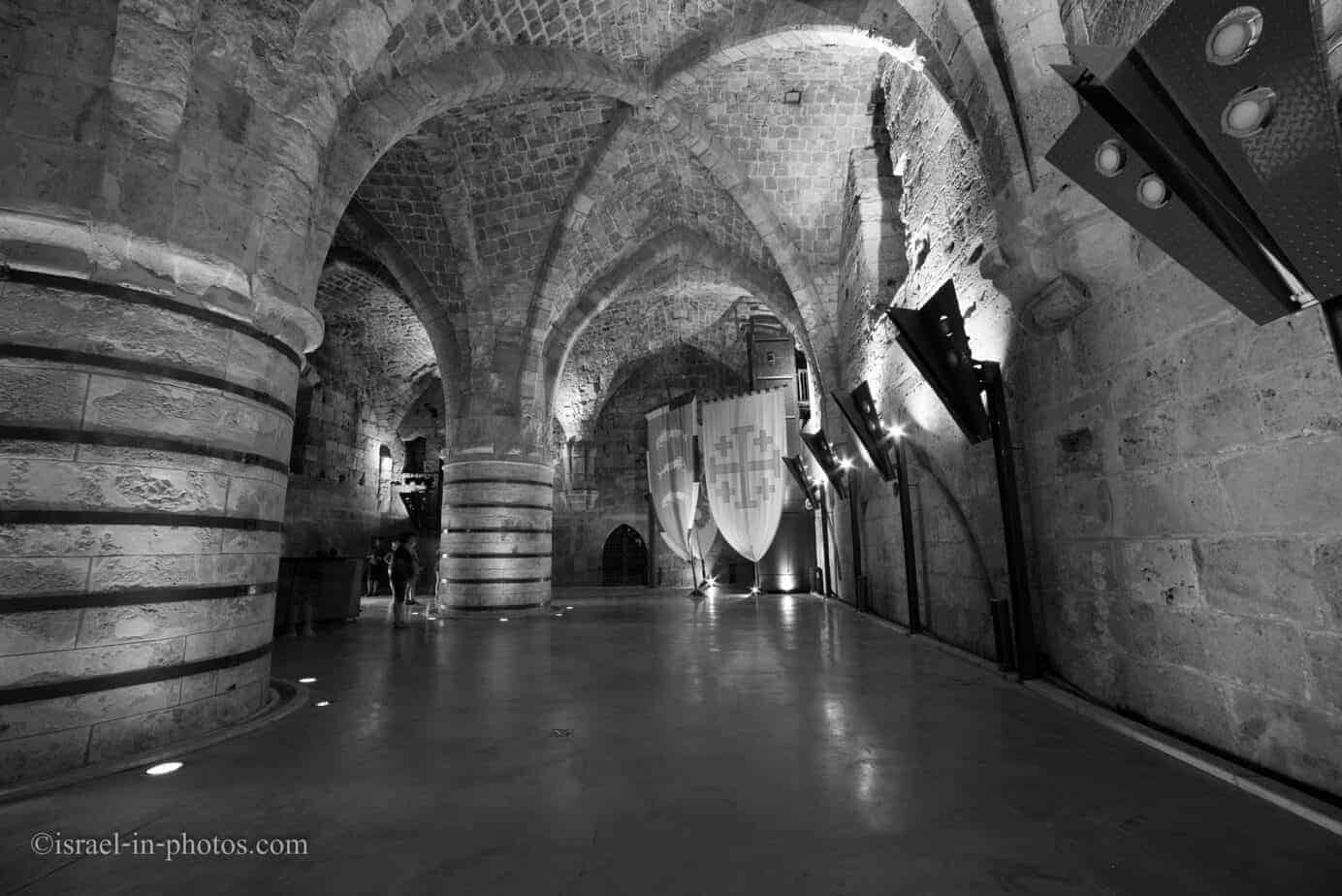

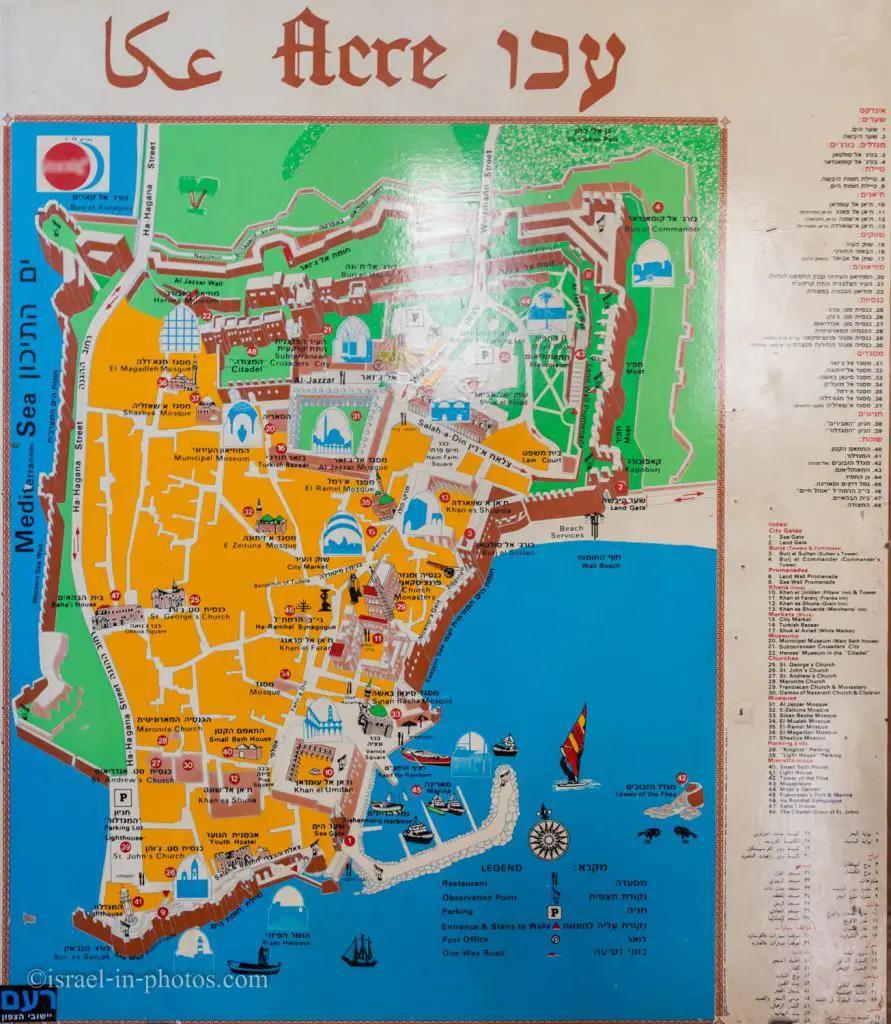
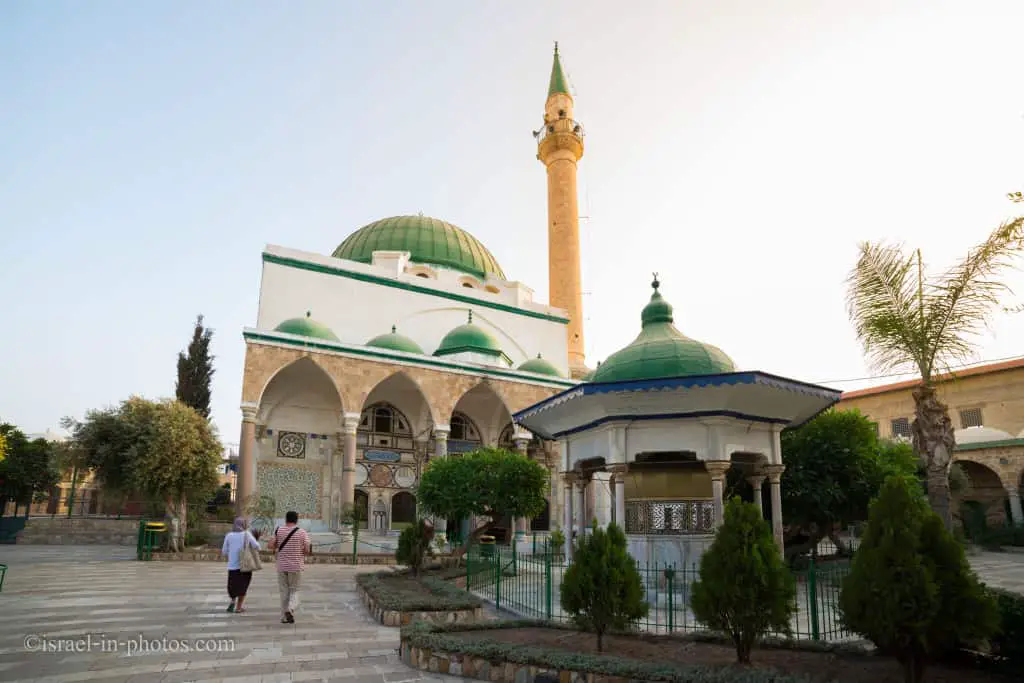
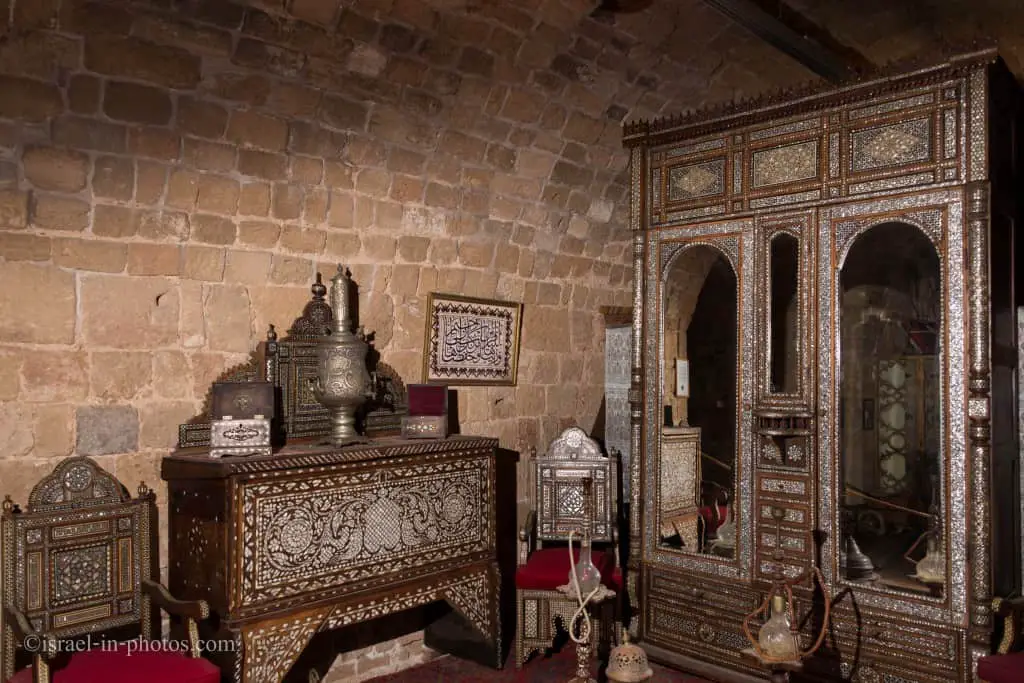
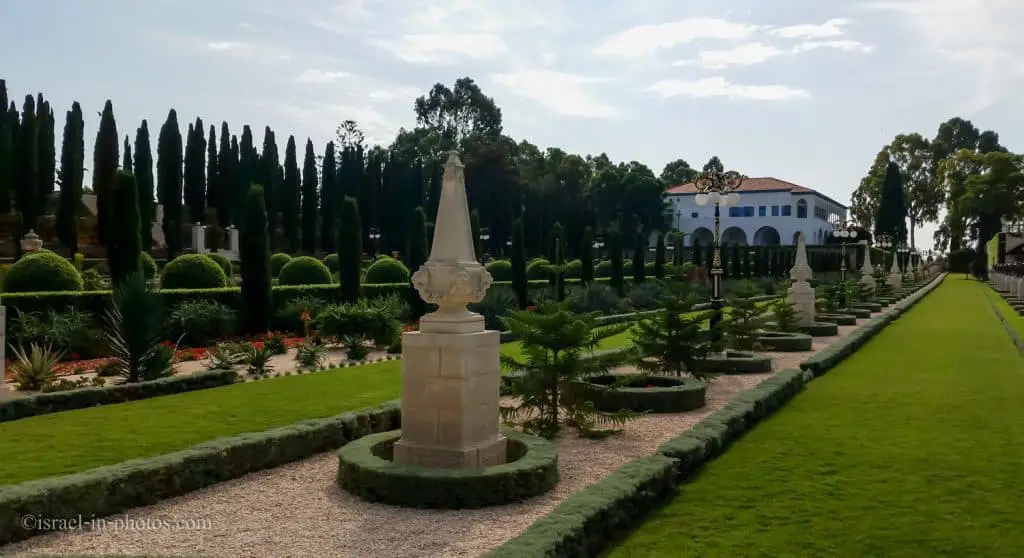
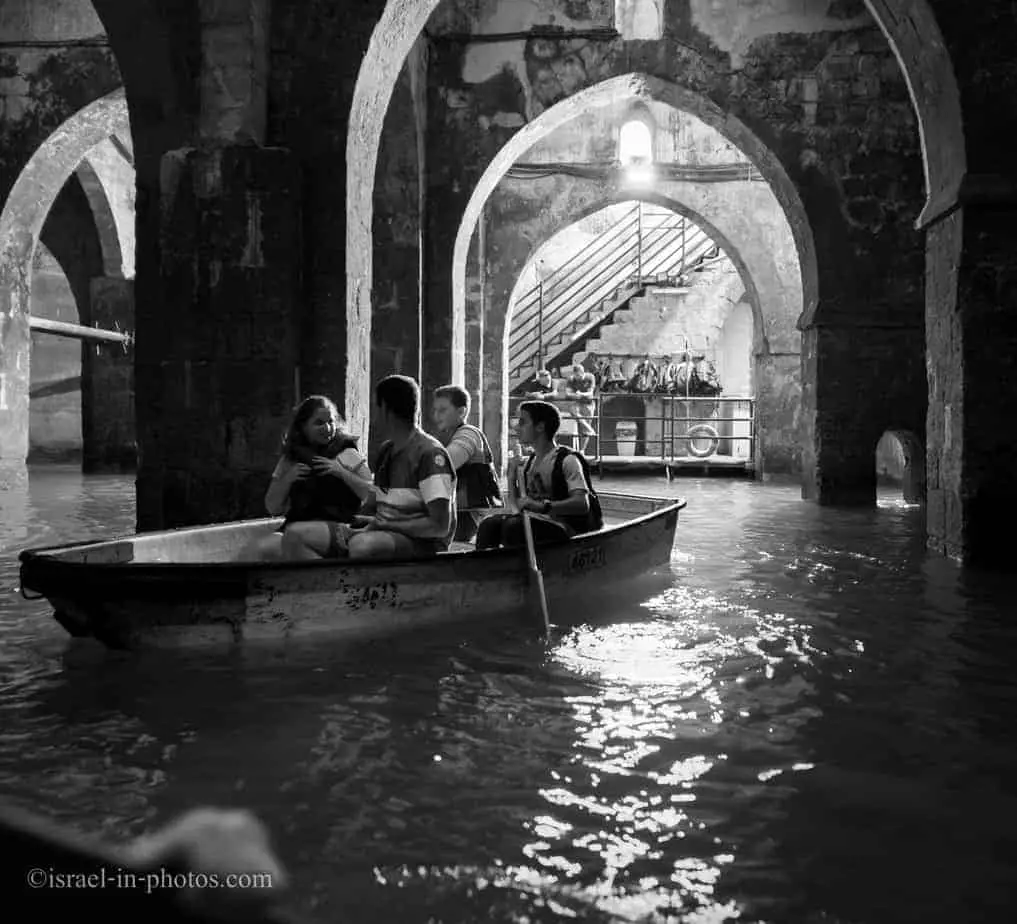
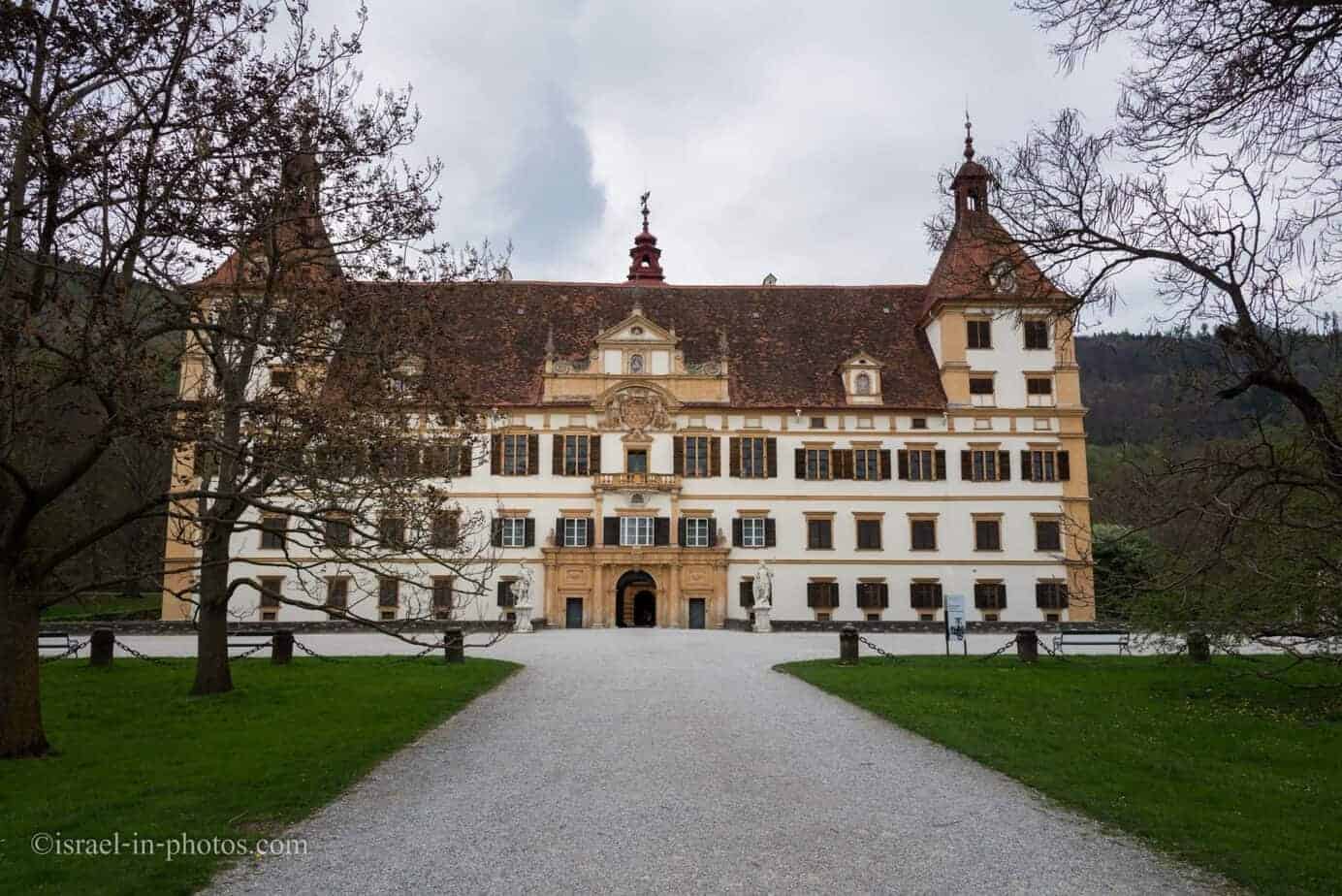


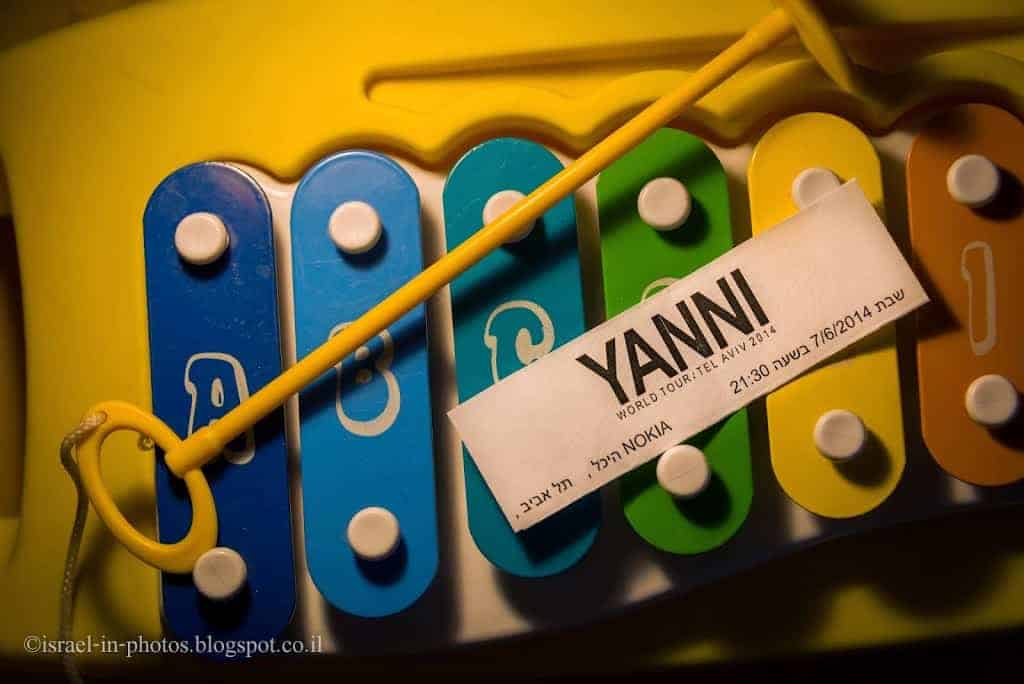
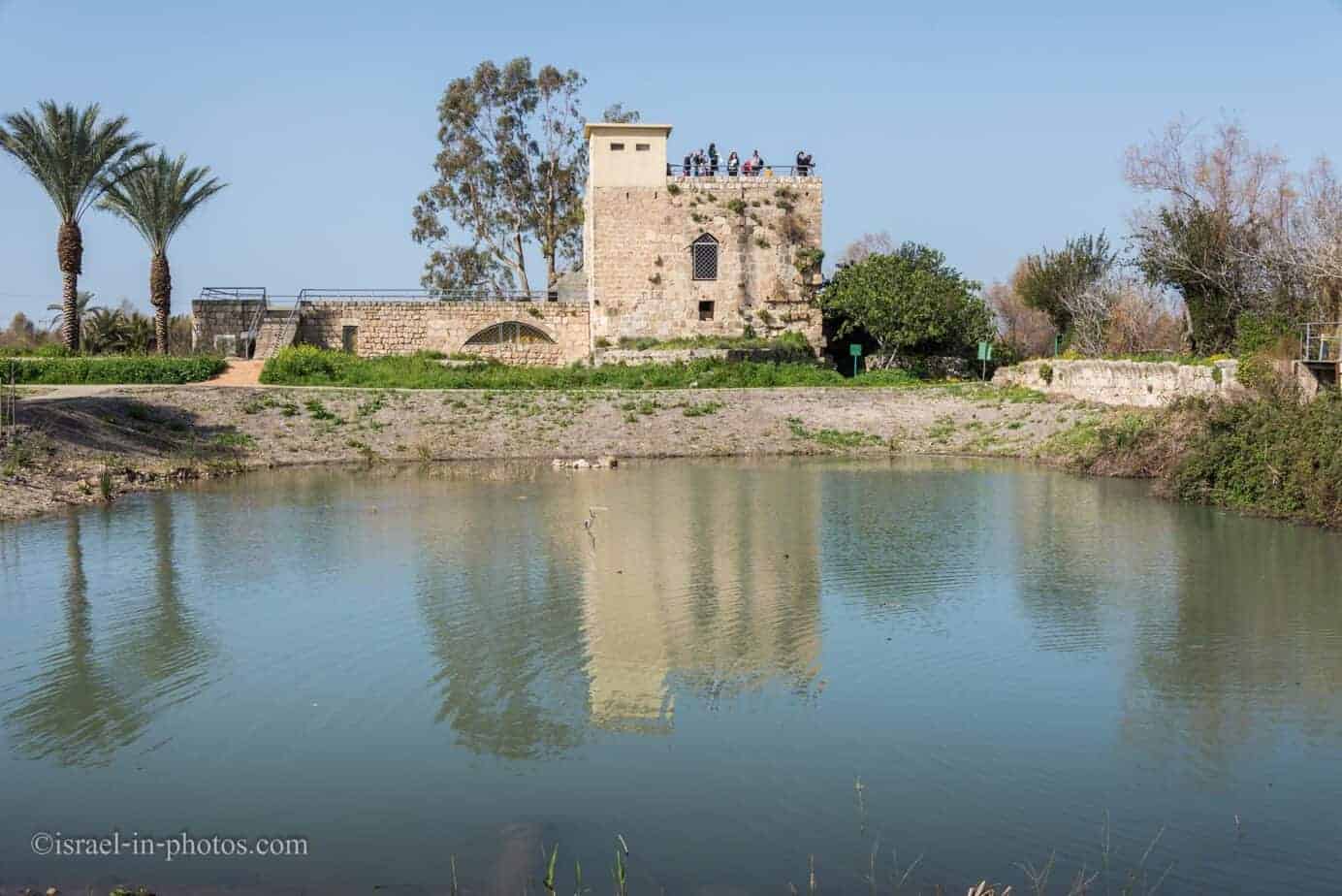
One Comment